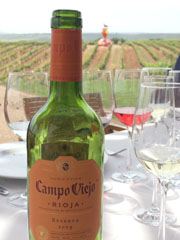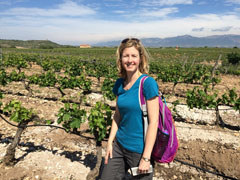Spotlight On: Campo Viejo
By Kori ~ June 5th, 2015.

Campo Viejo in Rioja, Spain
Campo Viejo was founded in 1959 by two winemakers from Rioja, Spain, Bernardo Beristain and Jose Ortigüela. The winery name, Campo Viejo, was inspired by the land in El Villar de Arnedo where Jose Ortigüela spent his childhood. Directly translated from Spanish to English, “Campo Viejo” means “old field”. Situated in the heart of Rioja in the Ebro Valley on a high plateau near Logroño, the winery offers beautiful panoramic views of the vineyards and nearby mountain ranges. After 56 years, Campo Viejo is still going strong, producing accessible and approachable wines in Rioja. Campo Viejo is the #1 Rioja producer in terms of sales worldwide with annual production at 2.1 million cases. Many of the Campo Viejo wines are widely available in the United States.
Elena Adell has been the chief winemaker at Campo Viejo since 1998. Born in Logroño in 1958, Elena has over 30 years of experience in the wine industry. In 2001, Campo Viejo built a new state-of-the-art winery. Elena was very involved with the plans for the new winery from the beginning and was able to work with the architectural team to design a facility with tradition and sustainability in mind. The production facility is underground and utilizes gravity in their winemaking processes. When the grapes come into their production facility, they are separated by variety, region, and so forth. The way Elena and her team works allows them to make wine on a large scale but in the manner of a smaller producer. In 2012, Campo Viejo became the first Spanish winery to achieve Carbon Neutral certification.

Elena Adell, Campo Viejo chief winemaker
Recently, I had the pleasure to visit Campo Viejo on a press trip to Rioja. I thoroughly enjoyed meeting Elena and getting a first-hand look at the Campo Viejo operation. The attention to detail in both the vineyards and winery is evident and quite amazing for a winery with such a large production level.
Rioja, located in north-central Spain, is probably the most well known wine region in Spain and one of the most prominent in the world. Red wines from Rioja are typically Tempranillo-based and may have some Garnacha (Grenache), Mazuelo, or Graciano blended in as well. Tempranillo is not particularly a fruit-driven wine, often showing aromas and flavors of wood and leather up front. Given this flavor profile, Tempranillo wines often seem older than they actually are. Taking its name from the Spanish word “temprano” which means early, Tempranillo tends to ripen early.
“I adore working with Tempranillo. It’s such a versatile grape. I love seeing the many different ways it can express its character in such a diverse range of wines.” –Elena Adell, Campo Viejo chief winemaker

Kori in the Campo Viejo vineyard
During my visit, we toured the vineyard located at the winery with Campo Viejo’s vineyard manager Mario Ezquerro. Rioja has diverse soils, geography, topography, and climates in its three sub-regions: Rioja Alta, Rioja Alavesa, and Rioja Baja. The winery is located in Rioja Alta, but Campo Viejo sources grapes from all three sub-regions. They are committed to sustainability and traceability and require each of their 800 growers to keep detailed records so Mario, Elena, and their team at Campo Viejo can make important decisions such as when to pick the grapes during harvest.
Elena’s attention to detail and emphasis on controlling every aspect of the winemaking process in order to produce consistently high quality wines at affordable prices is remarkable. While many winemakers stress the importance of vineyard practices, blending decisions, and the like, Elena is the first winemaker I’ve met who has talked to me about her involvement in selecting the wood to be used to make the barrels in which her wines will age. Obviously, I’ve talked to winemakers who are particular about their barrels and have distinct opinions about their barrels with a preference for oak from a certain country, i.e. American oak vs. French oak vs. Hungarian oak. However, Elena and the Campo Viejo team take it even one step further by traveling to France each year to personally select the wood from certain forests which is then brought back to Spain and made into barrels by their coopers.

Campo Viejo’s barrel room
We had the opportunity to taste a number of samples of the same wine, aged in barrels made by the same cooper, but whose wood came from different forests in France. We also tasted samples of the same wine, aged in barrels whose wood came from the same forest, but was produced by different coopers. The differences were noticeable and remarkable. Elena has studied those differences and uses them to create the blend she wants in each of her wines.
Campo Viejo produces a broad product range including a number of Tempranillo-based red wines, Garnacha, two white wines, and Tempranillo Rosé as well as two sparkling wines.
In the coming weeks, I will be writing more about the Campo Viejo wines. And if you are planning a trip to Spain anytime soon (which I highly recommend), feel free to ask me any questions about the area in the comments below or via our Contact Us form. I’m happy to help if I can.
Salud!
Filed under: General Wine Information, Spanish Wine, Spotlight On, Tempranillo, Vineyards, Wine Travel

 Wine Peeps is an independent wine blog dedicated to helping you get the most bang for your buck in wine. We do this through blind tastings of wine from around the world and calculations of
Wine Peeps is an independent wine blog dedicated to helping you get the most bang for your buck in wine. We do this through blind tastings of wine from around the world and calculations of 










